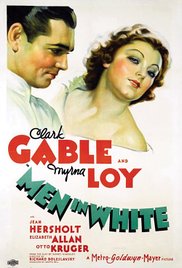
MEN IN WHITE
US, 1934, 74 minutes, Black and white.
Clark Gable, Myrna Loy, Jean Hersholt, Elizabeth Allen, Otto Krueger, Wallace Ford, Samuel S.Hinds.
Directed by Richard Boleslawsky.
Men in White is one of the earliest of the very popular genre of hospitals, doctors and the crisis they face.
It is a star vehicle for Clark Gable who had emerged in the previous four years as a character actor but also as a star. The film was released at the same time as his Oscar-winning It Happened One Night. Gable was to go on to more significant roles including the next year’s Mutiny on the Bounty as well as Gone with the Wind.
Myrna Loy was also emerging as a star at MGM, in many light comedies but, especially her many films with William Powell and the Thin Man series.
Jean Hersholt was a strong character actor at the time and Elizabeth Allen, from England, was to appear in Mark of the Vampire as well as A Tale of Two Cities, returning to England and appearing in such films as Graham Greene’s The Heart of the Matter in the early 1950s.
1. A popular film of the early 1930s, focusing on medicine, doctors and their dedication?
2. The hospital setting, surgery, the wards? The contrast with society life? Musical score?
3. The focus on George, a Clark Gable character, a talented doctor, working long hours, the range of patients, the little girl and his orders and the older, arrogant doctor, changing them and the consequences for her, George’s promises to her parents? His admiration for Dr Hochberg, hoping to go to Europe to study, the question or his relationship with Laura, her demands, phone calls, dates, his sudden becoming free, her surly response, coming to see him, the significance of the assistant nurse, George’s relationship with her, her illness, Laura befriending her, her death? George going to Europe? Laura allowing him to go – with some hope for the future?
4. Dr Hochberg, his expertise, his years of medical service, going back to the 1890s? His influence on George? On Laura?
5. Dramatising medicine and surgery in the 1930s – and in appreciating the range of changes in medical practice, which are mentioned, over the decades?
6. The touch of humour with Shorty, borrowing the clothes, the date…?
7. The nurse, her devotion, from England, working with George, the attraction, the relationship, her illness, the death?
8. A blend of melodrama with a tribute to the medical profession of the time?